Doubles service rules in badminton can be a bit tricky to understand. They are certainly trickier than service rules for singles, which are seen as much straight forward. For this reason, I decided to create this post, where I will explain in detail all you need to know about serving rules in doubles for badminton.
We will start with the a short explanation about the scoring. This is important in order to be able to jump to the next part. The second part is most confusing part, which is who serves from where at which moment. After that we will talk about more general service rules that apply to both singles and doubles. Let’s start!
Do you want to improve your badminton game? Then be sure to sign up for Badminton Famly+ by clicking here. Founded by former World Champion Thomas Laybourn, Badminton Famly+ is the best online training platform for badminton.
Scoring system rules
As I said, let’s start with a very short explanation about how the scoring works. This is mandatory in order to understand how the service works but, if you are already familiar with it, feel free to scroll down until the next section.
So, a match in badminton is played at the best of 3 games of 21 points each. What that means in doubles is that the first team to win two games wins the match.
With the current scoring system, every time a rally is played, a point is scored. The most important thing to remember from all this is that, in addition to winning the point, the winning side also serves in the following rally. This will come in handy when we explain a bit more about service rules in doubles.
For now, just keep it in mind. No matter what happens, whichever team wins the rally will be the team serving in the next rally.
If a game ties at 20-20, the side which first gains a 2 point lead will be the side that wins the game. A two point lead could be 22-20 or 27-25 to give two examples. If the match reaches 29-29, the side scoring the 30th point wins the game.
If there is another game, the team that has one the last point (and, as a result, the last game) will be the one starting to serve, following the logic of the system.
Serving in doubles
Now that we understand completely how the scoring works, it is time to jump onto the tricky part, the serving. The tricky part here is who serves when. In order to make it as easy to understand as possible, I will break it down into three basic rules. They are the following:
- Each side has only one service. This means that, if you start serving and you lose the point, the service “passes” to the other team.
- Players only change their respective service courts when they win a point while they are serving.
- When your score is even, you serve from the right side of the court. When your score is odd, you serve from the left side of the court.
If you understand these three basic rules, then you understand how the serving in doubles works. Let’s apply these rules now to the game with a few examples and see how it unfolds.
Example 01 – Starting the game
So, this is actually a very easy one. Once you start the game, the team serving (we call it Team AB) can decide who serves and the team receiving (we call it Team CD) can decide who receives. The only applicable rule here from the three basic rules is rule number three. Because your current score is 0, as an even number, the player that serves needs to start serving from the right.
In the image below you can see how that would play out. The player that serves is player A and the player that receives is player C.
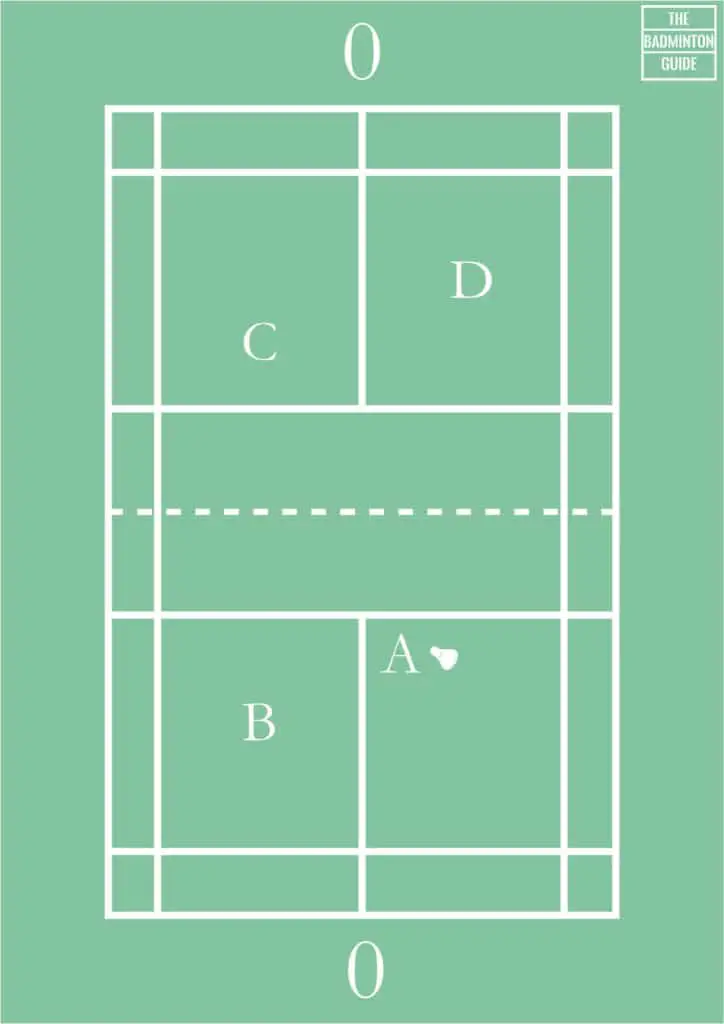
Example 02 – The serving team (Team AB) wins and the score is 1-0
Following the example above, imagine that the Team AB wins the rally and they score the point. If we go back to the three basic rules we know that:
- It doesn’t matter how many serves they have because they have won the rally while serving, so everything stays the same.
- Because they won a point while serving, the team serving will change the service court. The receiving team, because they did not win the point and they were not serving, stay in the same position.
- Because their score is now 1, that means that their score is odd, so they serve from the left. As it happens, the left is where the player A needs to go, so player A keeps serving. Another rule you can keep in mind is that you will keep serving as long as you keep winning the rallies. However, that rule is not really necessary to follow the right positions if you keep in mind the other three.
See below how the positions have evolved from the previous image.
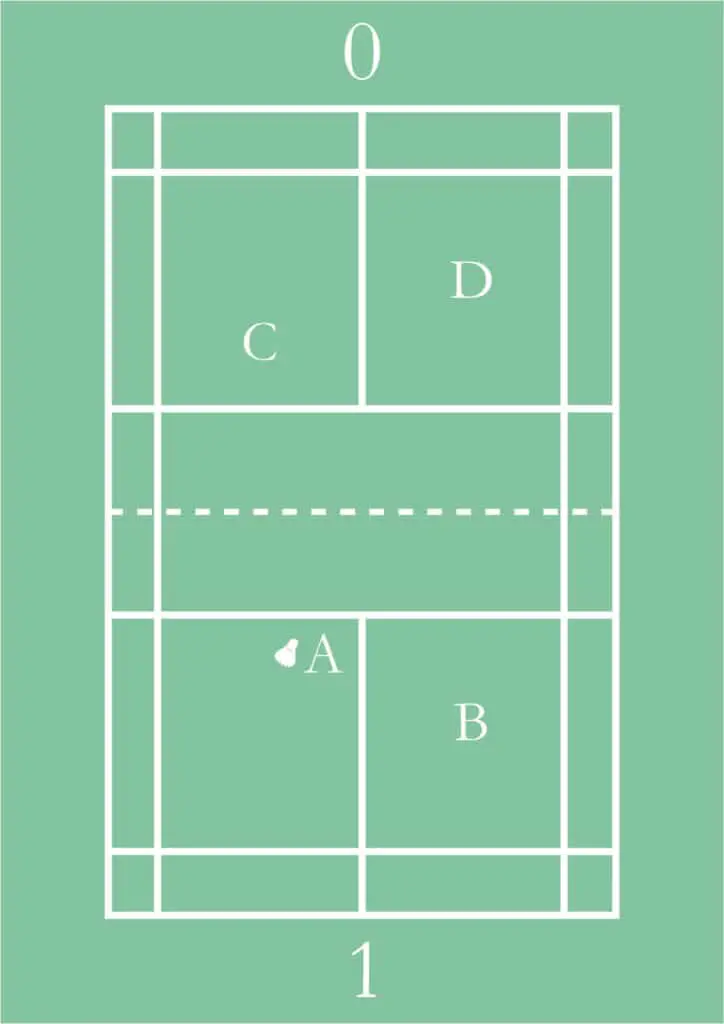
Example 03 – The receiving team (Team CD) wins and the score is 1-1
So, we keep going through the match. In this case, Team CV wins and the score is 1-1. Following the three rules we know that:
- Each side has only one serve. That means that, because they won the rally, Team CD is now serving.
- Because they won the point but they were not serving, that means that the players need to stay in the position they were in the previous point.
- Because their score is now 1, that means that they will be serving from the left side. This means that player D will be serving.
See below how the positions have evolved from the previous image.
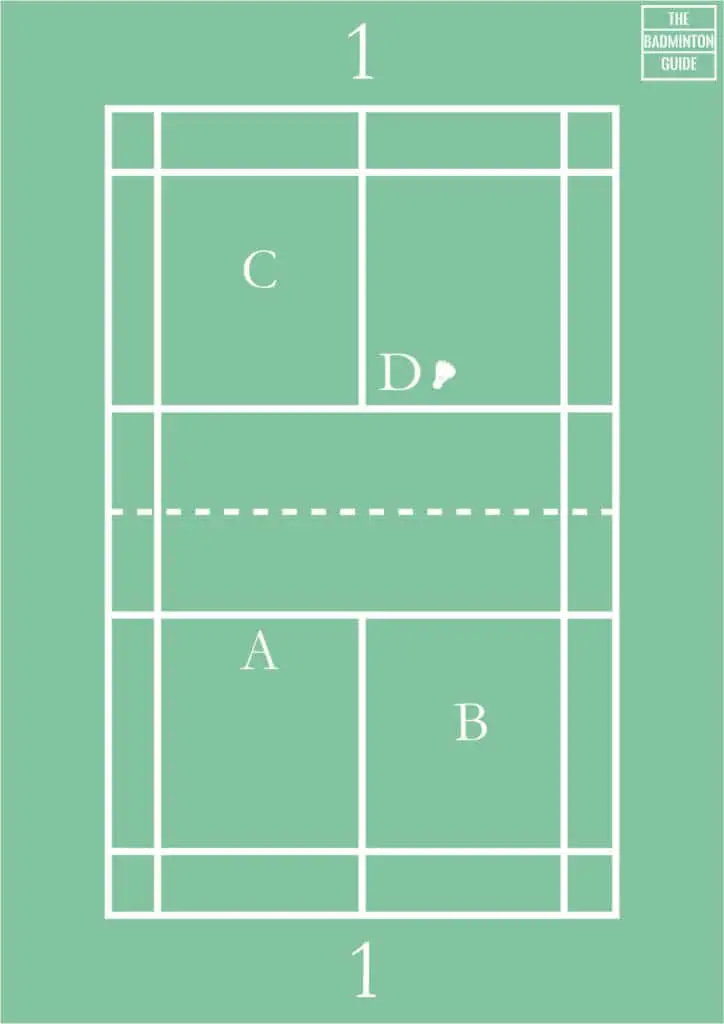
Example 04 – Team CD wins again and the score is 1-2
Another rally is played and Team CD wins again. That means that the score becomes 1-2.
Side note: If this was a real match, the team serving will always be called first in the scoring, so the score would actually be 2-1. However, to keep it clear, Team AB will always be the first in the score and Team CD will be second.
Let’s have a look at who would be serving from where keeping in mind the three basic rules.
- Rule number 1 doesn’t matter here because the team serving has won the rally.
- Because Team CD has won the rally while serving, that means they get to switch sides.
- Because their score is now 2, that means they serve from the right side, where player D (who was serving already) is.
In the image below you can see how the positions have changed from the previous image.
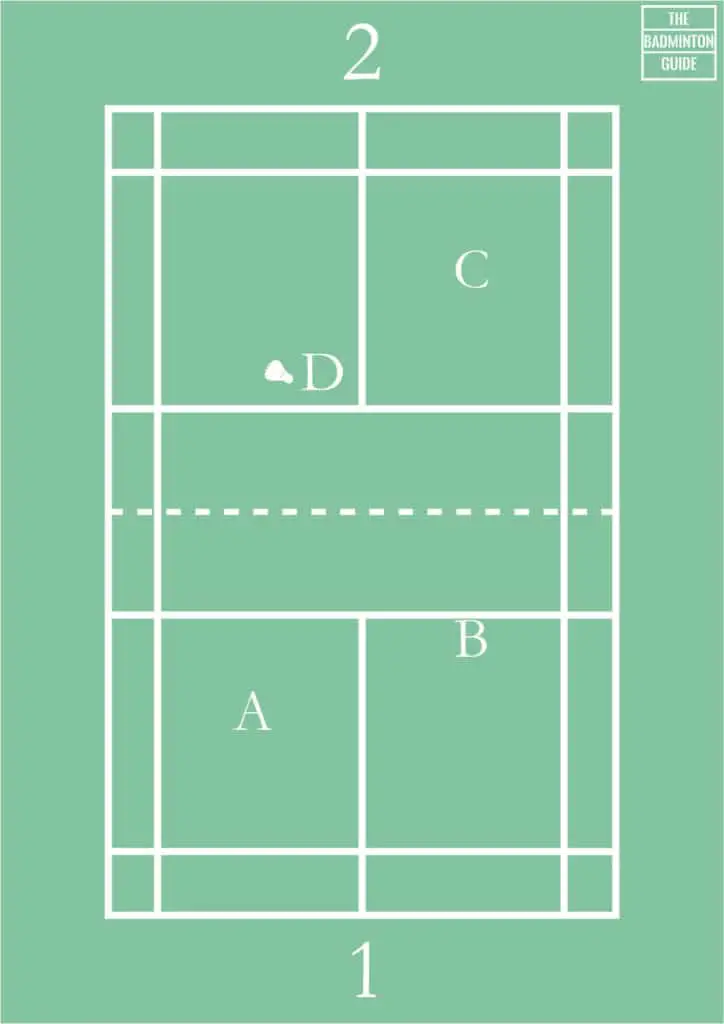
Example 04 – Team CD wins again and the score is 1-3
Another point for Team CD, which puts the score at 1-3. In this case, the logic is the same as before. Team CD switches service courts and, because the score is now three, they serve from the left, where player D is. This is the same exact situation as when the score was 1-1.
You can see the positions in the image below.
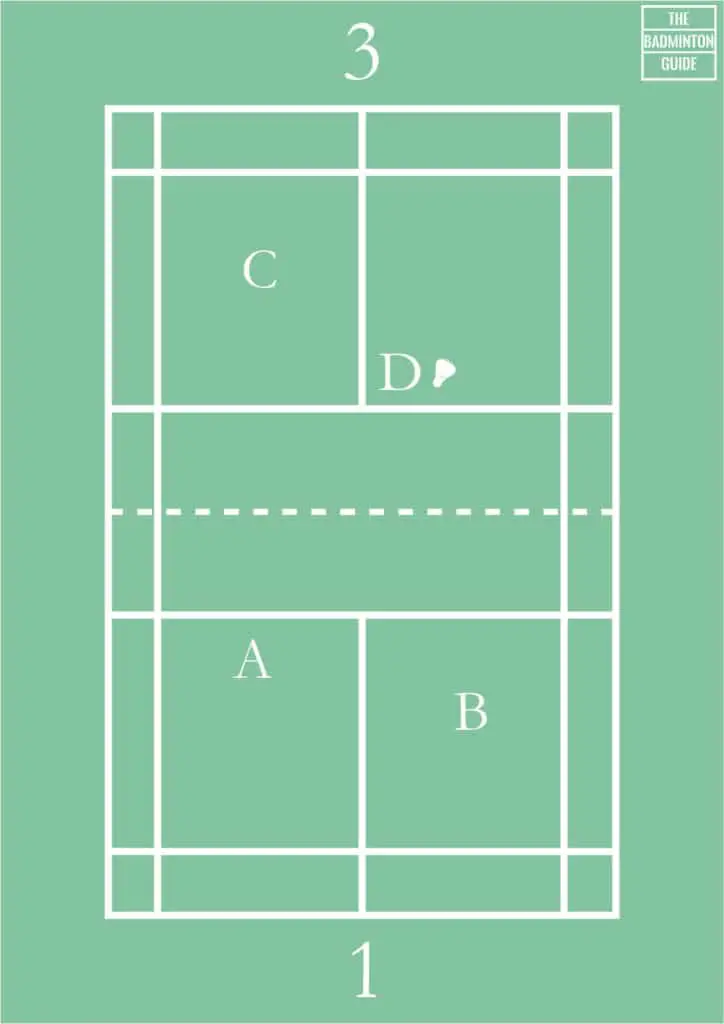
Example 05 – Team AB wins and the score is 2-3
This is the last example and I hope with this you already got the hang of it. In this case, Team AB wins the rally and they score the point. Before you read on and have a look at the image, just think for yourself what would happen. I hope you can answer the situation correctly If so, you already understand the principles and it is a matter of just practicing them a few times before they become second nature.
Let’s see if you understood it.
- Because there is only one serve and Team CD lost the point, the serve goes to the winners, Team AB.
- As they did not hold the serve before, Team AB does not change positions.
- Because their score is now 2, they serve from the right. That means that player B will be serving. Another thing you can keep in mind is that, because of how these rules are created, the serving person will always alternate. So, if you were serving and you lose the rally, the next time your team wins the rally and you can serve, it will be your partner serving.
Let’s have a look at the image below for the positions of the players as described in this last example.
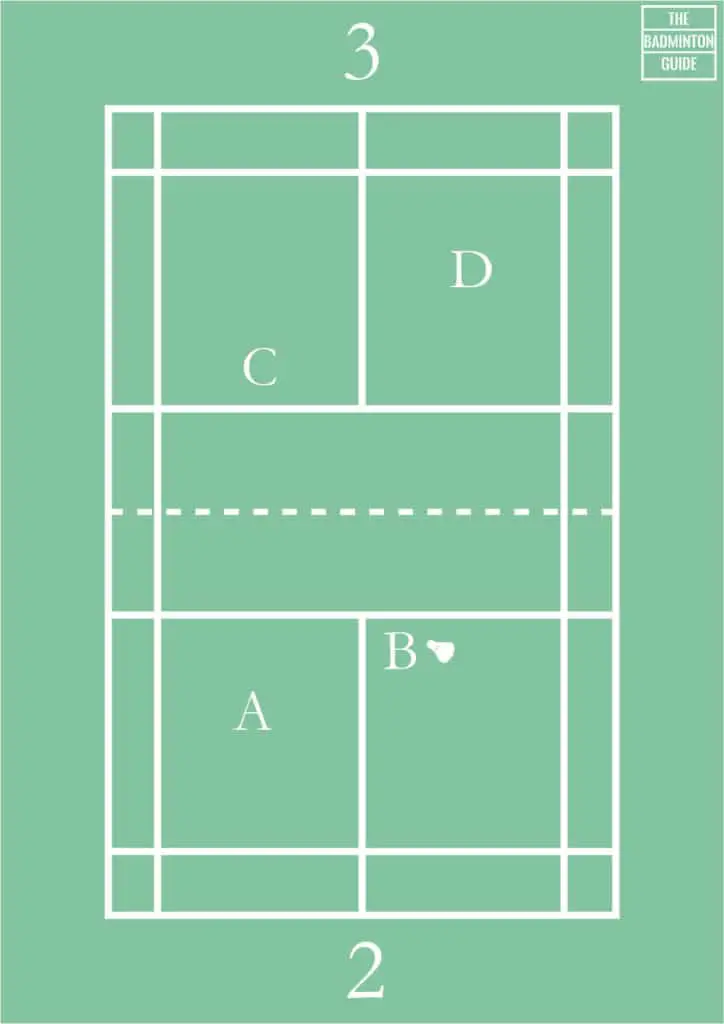
Service rules
Now that we have a clear understanding of where each player needs to be located depending on the situation, let’s look into more general service rules. These rules apply to both singles and players. However, because in doubles the service is much more critical to the success of the match, players tend to go as close to the illegality as possible more often in doubles than in singles.
Let’s look at each specific rule.
Serving diagonally
The most basic rule for both types of matches is that you always serve diagonally as happens in other racket sports like tennis. So, if you are serving from the right side of the court, you will serve to the right side of the court of your opponent, thus diagonally.
Both feet of the server and the receiver have to be in contact with the court and stay within the margins while serving
Moreover, some part of both feet of the server and the receiver have to remain in contact with the surface of the court in a stationary position from the start of the service until the service is delivered.
What that means is that the receiver cannot move before the service is delivered. This is something that happens quite often, especially at lower levels where there is no service judge. In that case, it is difficult to spot because the umpire will be looking at the server and no one will keep an eye on the receiver, so some players take advantage of that.
It is also mandatory that the part of the feet in contact with the court does not touch the lines that mark your position, be it the front line or the sideline. This is true for both the server and the receiver.
All the shuttle has to be below waist height when hitting the shuttle
In order to perform the service correctly, it is mandatory that the shuttle is below waist height when it is being hit in the service movement.
The waist is considered to be an imaginary line around the body, at the same height as the lowest part of the server’s bottom rib.
This one is probably the one where more controversy arises during matches. A lot of people complain about the height of the opponent’s serve, especially if the server is trying to maximize the height as much as possible.
The racket head and the shaft have to be pointing down while serving
In addition to the shuttle being below waist height, another important element is that the racket head and shaft have to be pointing down while serving.
The higher you serve, the easier it is also to commit this fault.
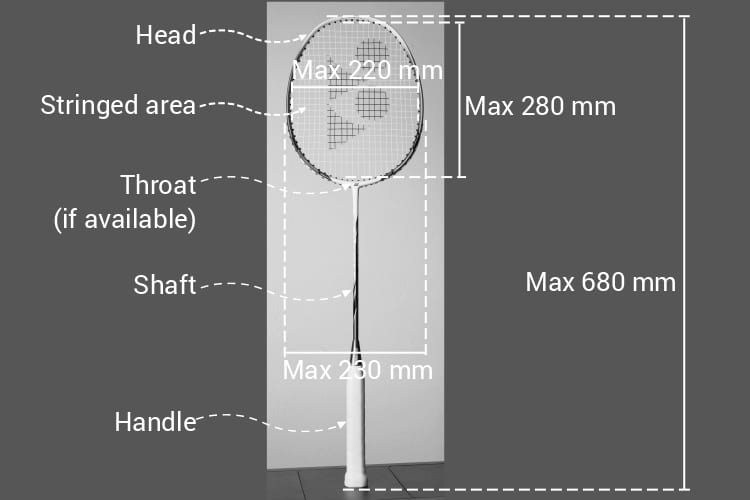
The server’s racket shall initially hit the base of the shuttle
When serving, it is also mandatory to hit the base of the shuttle first. The base of the shuttle is the cork, the semispherical part that is always the one that flies towards you when in play.
So, when serving for doubles, make sure that you position the shuttle in a way that you will always be hitting the base first.
You cannot stop a service movement once it has started
If you start with your backward movement in order to serve, any delay at the start of the service can be considered an undue delay. If that was the case, the umpire or service judge can call a fault and you can lose the rally.
Final words
And with this, we have arrived at the end of this post. If you enjoyed it and you want to learn something else about badminton rules, you can check our Badminton Game Rules Guide, where I have explained all the rules of badminton in a clear-to-understand language, although not as much in detail as the serving in doubles.
If you enjoyed this post or you have any remaining doubts about what I explained here, please let me know in the comments below.

